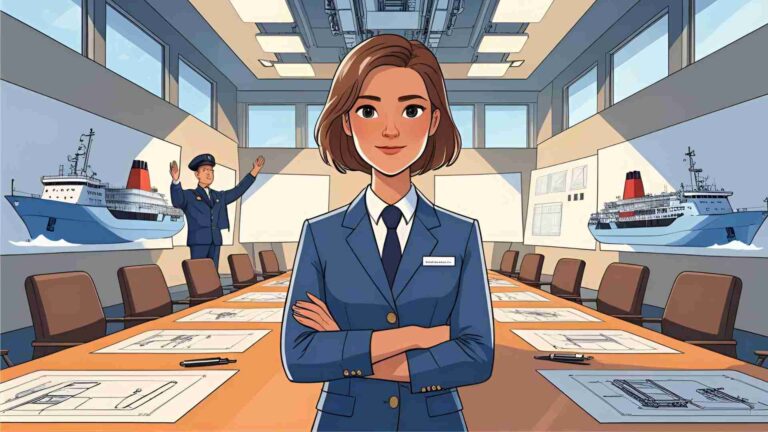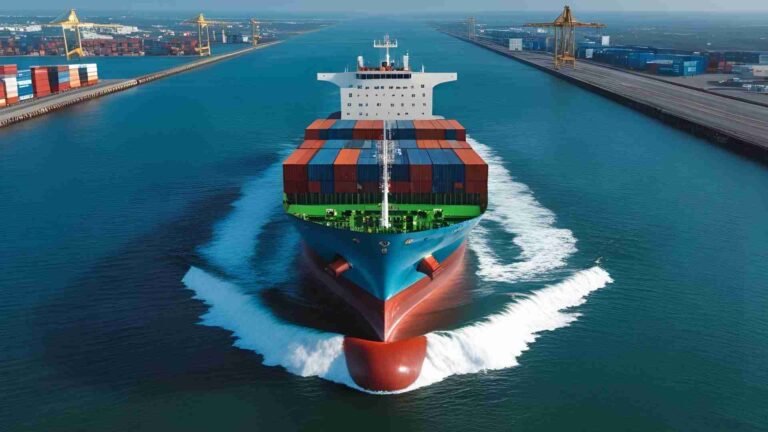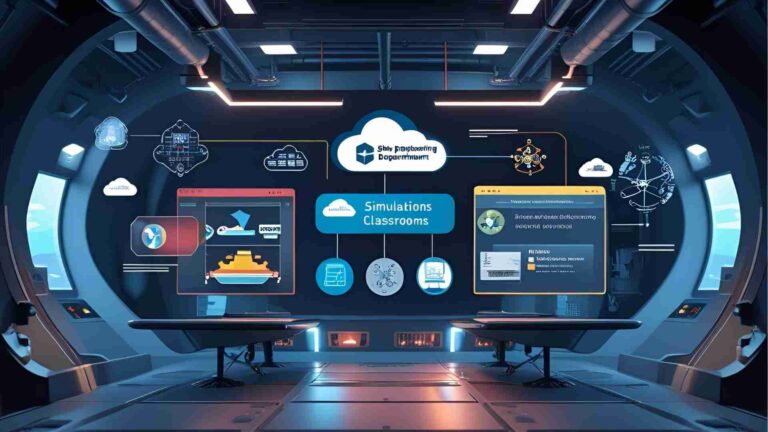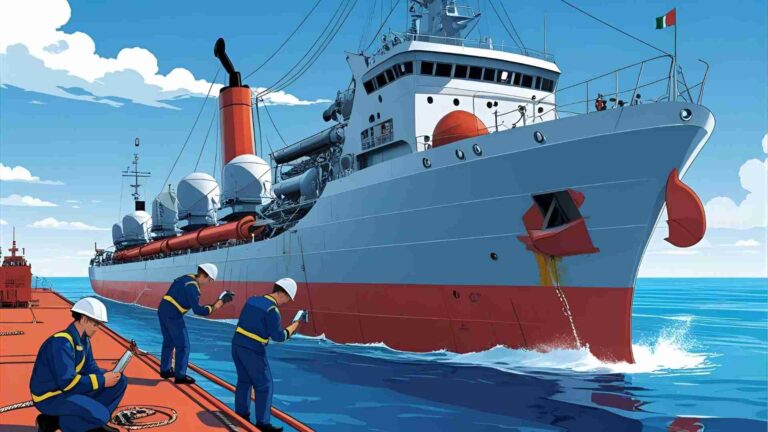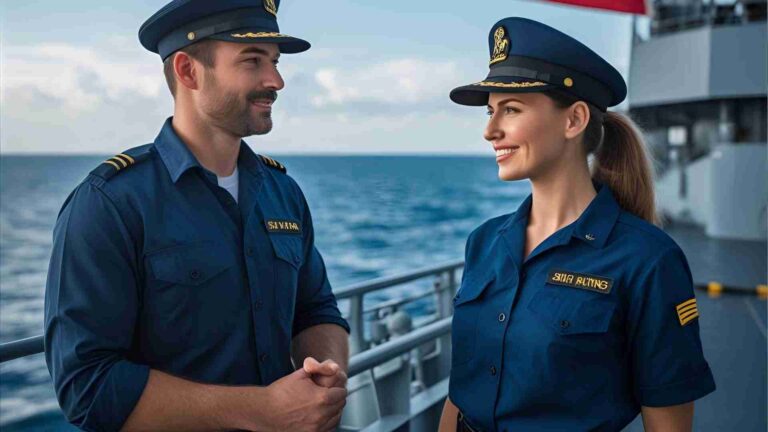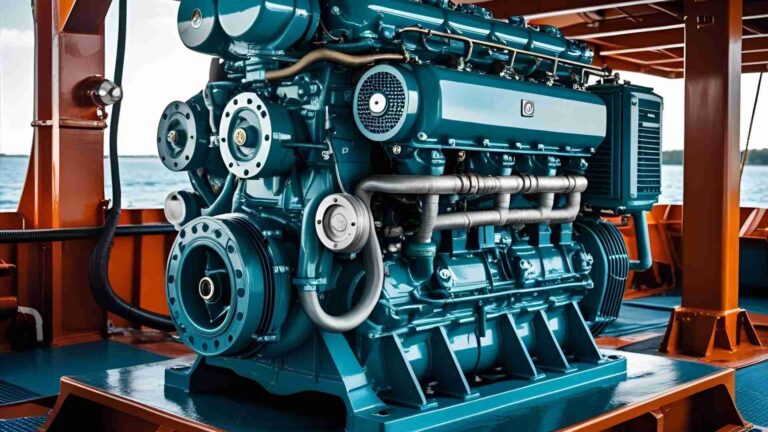Your Guide to Tackle Emergency Situations On Board Ships
Master shipboard emergency procedures with our guide on fire, man overboard, and abandon ship protocols for maritime safety.
Maritime operations are inherently challenging, with ships navigating unpredictable seas, extreme weather, and confined environments. Ensuring safety on board is critical to protect lives, property, and the environment. This guide provides an in-depth exploration of emergency procedures, safety measures, and protocols to equip seafarers with the knowledge and confidence to handle crises effectively. From fire response to man overboard incidents, we cover essential strategies, equipment, and international regulations to ensure preparedness.
The Importance of Maritime Safety
The maritime industry is the backbone of global trade, transporting over 80% of the world’s goods. However, the marine environment presents unique risks: rough seas, dense fog, crowded shipping lanes, and the potential for fires or mechanical failures. These hazards can lead to catastrophic outcomes, including loss of life, environmental damage, and economic disruption. Effective emergency procedures are vital to mitigate these risks, ensuring the safety of crew, cargo, and ecosystems.
Key Challenges in the Marine Environment
- Unpredictable Weather: Storms, high winds, and heavy seas can destabilize vessels or impair navigation.
- Confined Spaces: Limited escape routes increase the danger of fires and toxic gas buildup.
- Isolation: Ships often operate far from immediate rescue or medical services, necessitating self-reliance.
- Human Factors: Panic or lack of training can exacerbate emergencies, underscoring the need for preparedness.
Adhering to international safety standards and maintaining rigorous training protocols are essential to overcoming these challenges.
International Maritime Safety Regulations
The International Maritime Organization (IMO) is the global authority for regulating shipping safety, environmental protection, and efficiency. The IMO’s conventions provide a framework for standardized emergency preparedness and response.
Key IMO Conventions
| Convention | Focus Area | Key Provisions |
|---|---|---|
| SOLAS (Safety of Life at Sea) | Ship safety, construction, and emergency procedures | Mandates life-saving appliances, fire safety systems, and crew training. |
| MARPOL (Prevention of Pollution from Ships) | Environmental protection | Regulates oil spills, hazardous material handling, and waste management. |
| STCW (Standards of Training, Certification, and Watchkeeping) | Crew competency | Ensures seafarers are trained in emergency response, navigation, and safety protocols. |
| ISM Code (International Safety Management) | Safe ship management | Requires companies to maintain a Safety Management System (SMS) for emergency preparedness. |
| ISPS Code (International Ship and Port Facility Security) | Security | Addresses piracy, terrorism, and other security threats. |
These conventions ensure ships are equipped, crews are trained, and procedures are standardized globally.
Personal Protective Equipment (PPE) for Maritime Safety
Personal Protective Equipment (PPE) is critical for safeguarding seafarers from workplace hazards. Proper use and maintenance of PPE reduce the risk of injuries in high-risk environments like engine rooms or cargo holds.
Common Types of PPE
| Equipment | Purpose | Example Use Case |
|---|---|---|
| Helmets | Protect against head injuries | Used during cargo handling or in areas with low clearance. |
| Safety Goggles/Face Shields | Shield eyes from debris, chemicals, or bright light | Essential for welding or handling hazardous materials. |
| Ear Protection | Prevent hearing loss in noisy environments | Mandatory in engine rooms with high-decibel machinery. |
| Life Jackets/Immersion Suits | Ensure survival in water | Worn during abandon ship or man overboard scenarios. |
| Safety Gloves | Protect hands from cuts, burns, or chemicals | Used during maintenance or handling ropes. |
| Safety Footwear | Prevent foot injuries and slips | Steel-toe boots for deck operations. |
PPE Maintenance and Training
- Inspection: Regularly check PPE for wear and tear to ensure functionality.
- Training: Crew must be trained in correct PPE usage, storage, and limitations.
- Accessibility: PPE should be stored in easily accessible locations, clearly marked for emergency use.
Core Emergency Procedures on Ships
Effective emergency response hinges on preparedness, clear communication, and adherence to structured protocols. Below are the primary emergency scenarios and their response strategies.
General Alarm
The general alarm is the first step in most emergencies, signaling the crew to muster and prepare for action.
Procedure:
- Sound the Alarm: Use the ship’s PA system or manual alarms to alert all personnel.
- Muster: Crew gathers at designated muster stations with life jackets and immersion suits.
- Headcount: Verify all personnel are accounted for.
- Follow Instructions: Act according to the officer in charge and the vessel’s Muster List.
Fire Response
Fires are among the most dangerous shipboard emergencies due to confined spaces and flammable materials.
Procedure:
- Raise Alarm: Inform the Officer on Watch and confirm if the alarm is genuine.
- Activate Systems: Start fire and bilge pumps, close fire and watertight doors.
- Contain Fire: Use portable extinguishers for small fires; deploy fixed systems (e.g., CO2) for larger fires.
- Evacuate if Necessary: Muster crew and prepare for potential evacuation.
Firefighting Equipment:
| Equipment | Type | Use Case |
|---|---|---|
| Fire Extinguishers | Water, Foam, CO2, Dry Chemical | Suitable for electrical, oil, or solid material fires. |
| Fire Hoses/Hydrants | High-pressure water | For large-scale fire suppression. |
| Fixed Systems | CO2, Foam | Deployed in engine rooms or cargo holds. |
| Breathing Apparatus | Self-contained | Allows safe entry into smoke-filled areas. |
Chart: Fire Response Workflow
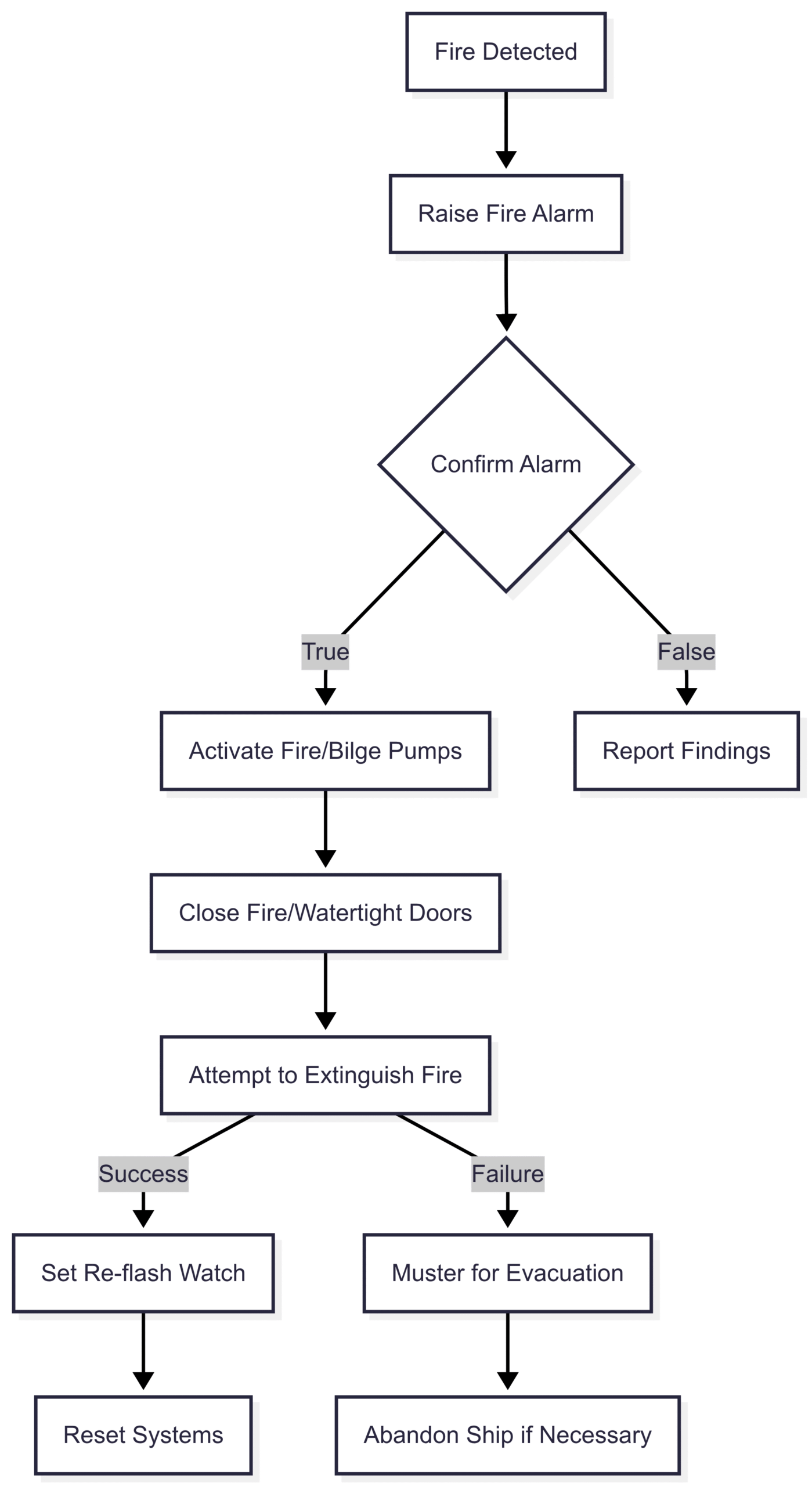
Man Overboard
A man overboard incident requires immediate action to locate and rescue the individual.
Procedure:
- Raise Alarm: Alert the bridge and crew immediately.
- Mark Location: Deploy lifebuoys, smoke markers, or flares to mark the spot.
- Maneuver Vessel: Perform a Williamson turn or similar maneuver to return to the location.
- Assign Spotter: Designate a crew member to maintain visual contact.
- Rescue: Use rescue boats or nets to recover the person, followed by first aid.
Chart: Man Overboard Response

Abandon Ship
Abandoning ship is a last resort when the vessel is no longer safe.
Procedure:
- Muster: Gather at designated stations with life jackets and immersion suits.
- Prepare Supplies: Collect rations, water, and warm clothing.
- Deploy Lifeboats/Liferafts: Launch conventional or free-fall lifeboats, or inflatable liferafts.
- Board Safely: Ensure orderly boarding and weight distribution.
- Signal for Rescue: Use flares, EPIRBs, or radios to alert rescuers.
Lifeboat and Liferaft Specifications:
| Type | Capacity | Features | Cost (Approx.) |
|---|---|---|---|
| Conventional Lifeboat | 20-150 persons | Enclosed, motor-driven, survival supplies | $50,000-$200,000 |
| Free-fall Lifeboat | 20-60 persons | Rapid deployment, ramp-launched | $100,000-$300,000 |
| Inflatable Liferaft | 6-50 persons | Auto/manual deployment, survival kits | $5,000-$20,000 |
Severe Weather
Navigating through storms requires proactive measures to ensure stability and safety.
Procedure:
- Monitor Conditions: Use weather forecasting tools to track storms.
- Reduce Speed: Slow the vessel to maintain control.
- Secure Items: Stow loose equipment to prevent shifting.
- Assess Stability: Check ballast and cargo distribution.
Hazardous Material Spills
Spills of oil or chemicals can harm the crew and environment, requiring swift containment.
Procedure:
- Contain Spill: Use absorbent materials or booms to limit spread.
- Notify Authorities: Inform the Master and relevant agencies per the Shipboard Oil Pollution Emergency Plan (SOPEP).
- Clean Up: Safely remove contaminated materials.
- Decontaminate: Clean affected areas and personnel.
- Report: Document the incident for regulatory compliance.
SOPEP Equipment:
| Item | Purpose | Approx. Cost |
|---|---|---|
| Absorbent Pads | Soak up oil spills | $50-$200 per pack |
| Containment Booms | Prevent spill spread | $1,000-$5,000 |
| Skimmers | Remove oil from water | $10,000-$50,000 |
The IS-SAFE Schema for Emergency Planning
To streamline emergency responses, the IS-SAFE schema aligns with IMO Resolution A.1072(28) for integrated contingency planning. It provides a structured, two-tier approach to harmonize procedures across emergencies.
IS-SAFE Framework
- Initial Actions:
- 1a. Immediate Assessment: Activate alarms, assess the situation, and deploy resources.
- 1b. Shoreside Response: Notify authorities and activate company response procedures.
- Subsequent Responses:
- 2a. Substantial Control: Implement technical measures (e.g., firefighting, containment).
- 2b. Additional Reporting: Update stakeholders like coastguards, insurers, and flag states.
- 2c. Follow-up Actions: Restore operational readiness and investigate the incident.
- 2d. Post-Emergency: Document non-conformities, brief stakeholders, and plan recovery.
Chart: IS-SAFE Workflow
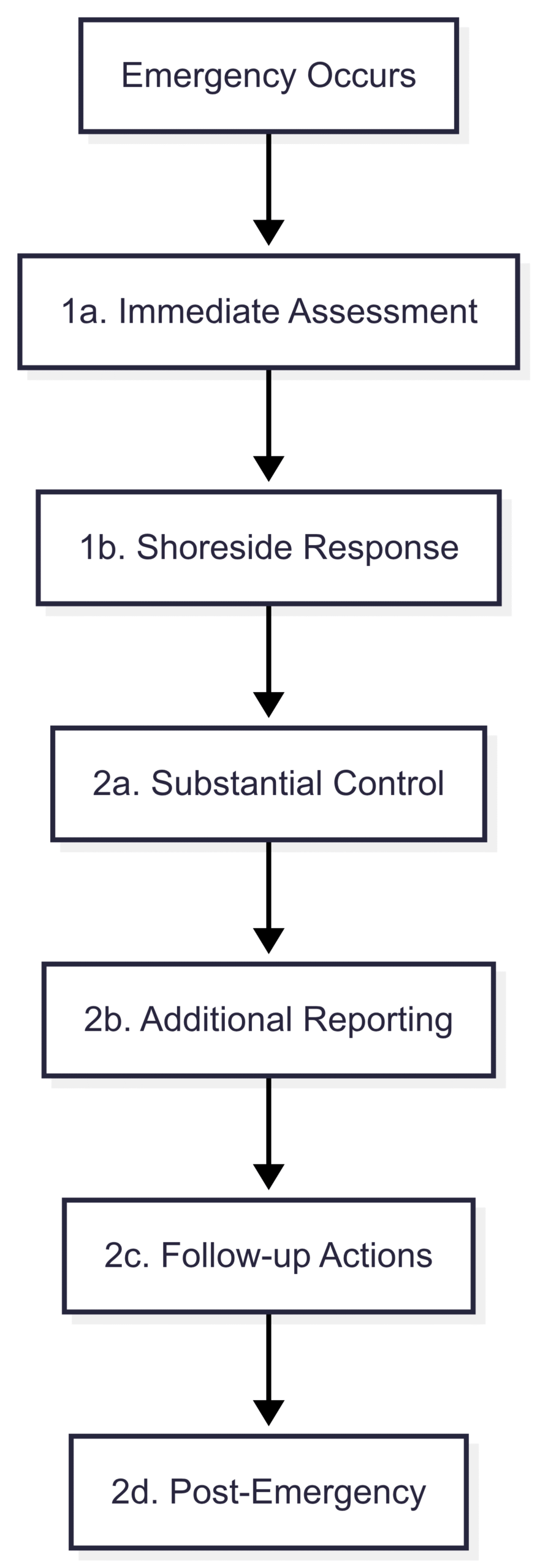
Example: Galley Fire Response Using IS-SAFE
- 1a. Immediate Assessment: Raise alarm, activate pumps, close doors, muster crew.
- 1b. Shoreside Response: Issue Mayday, notify company per ISM Code.
- 2a. Substantial Control: Deploy CO2 systems, isolate electricals, cool boundaries.
- 2b. Additional Reporting: Downgrade to Pan-Pan, inform SOPEP contacts.
- 2c. Follow-up: Ventilate spaces, reset systems, preserve evidence.
- 2d. Post-Emergency: Report to P&I, Class, and Flag; determine port of refuge.
Training and Drills: The Backbone of Preparedness
Regular drills and training ensure crew readiness and familiarity with equipment and procedures.
Common Drills
- Fire Drills: Practice extinguishing fires and evacuating.
- Abandon Ship Drills: Simulate lifeboat and liferaft deployment.
- Man Overboard Drills: Train in rescue maneuvers and recovery.
- SOPEP Drills: Rehearse spill containment and cleanup.
Training Requirements
- STCW Certification: Mandatory for all seafarers, covering basic safety, firefighting, and survival techniques.
- First Aid Training: Includes DRSABCD (Danger, Response, Send, Airway, Breathing, CPR, Defibrillator).
- Specialized Training: For handling hazardous materials or operating specific equipment.
Communication and Coordination
Effective communication is critical during emergencies to coordinate actions and ensure safety.
Tools and Systems
- VHF Radios: For short-range communication with nearby vessels or MRCCs.
- Satellite Phones: For long-range contact in remote areas.
- GMDSS: Enables distress signaling and SAR coordination.
- PA Systems: For internal crew updates and instructions.
Role of MRCCs
Maritime Rescue Coordination Centers (MRCCs) orchestrate SAR operations, liaising with vessels, aircraft, and shore authorities to ensure timely rescues.
Continuous Improvement in Safety
Safety is an ongoing commitment. Regular reviews of procedures, incident investigations, and updates to contingency plans are essential to address evolving risks.
Best Practices
- Risk Assessments: Conduct before hazardous tasks to identify and mitigate risks.
- Incident Reviews: Analyze emergencies to improve future responses.
- Equipment Maintenance: Ensure firefighting, life-saving, and communication systems are operational.
- Crew Feedback: Incorporate seafarer input to refine procedures.
Conclusion
Handling emergencies on board ships demands preparation, clear protocols, and calm execution. By mastering procedures for fires, man overboard incidents, abandon ship scenarios, and hazardous spills, seafarers can protect lives and the environment. The IS-SAFE schema, aligned with IMO standards, provides a structured approach to streamline responses. Through rigorous training, regular drills, and robust communication, crews can navigate crises with confidence, ensuring safety remains paramount in the maritime industry.
Happy Boating!
Share Your Guide to Tackle Emergency Situations On Board Ships with your friends and leave a comment below with your thoughts.
Read Boat Wheel Image 4K HD Wallpapers until we meet in the next article.

